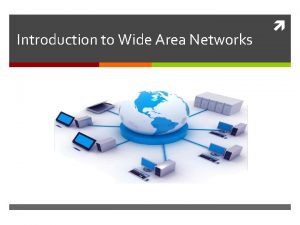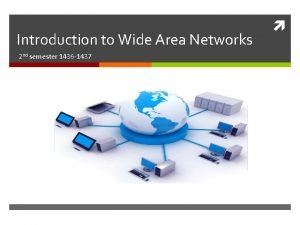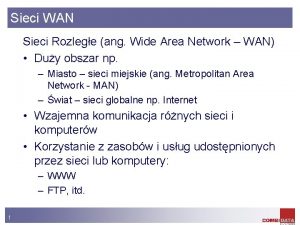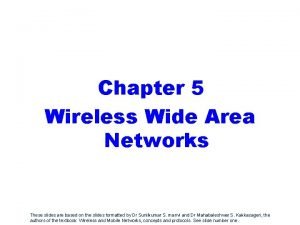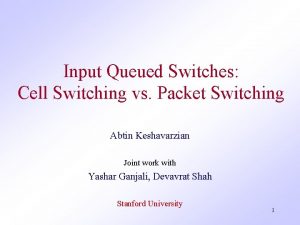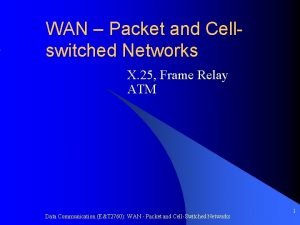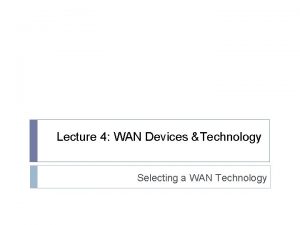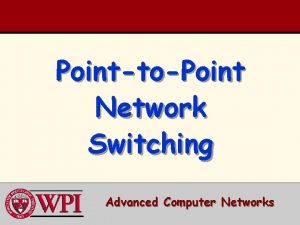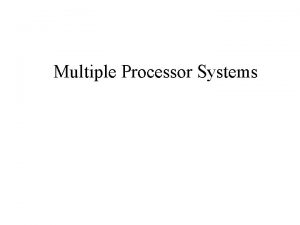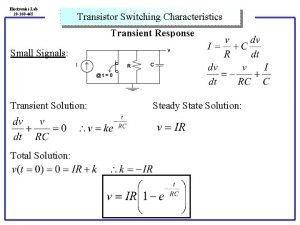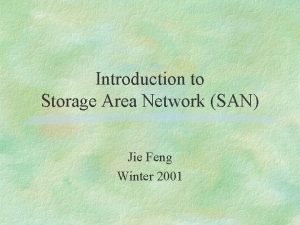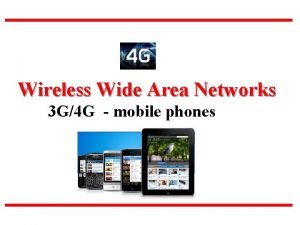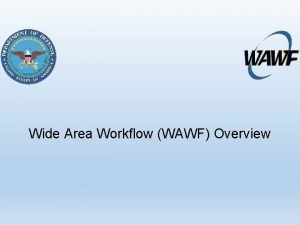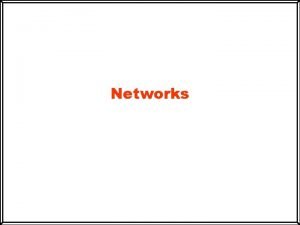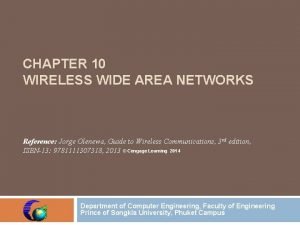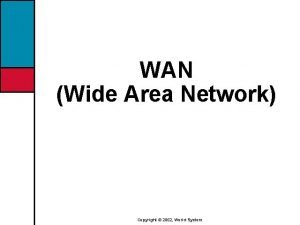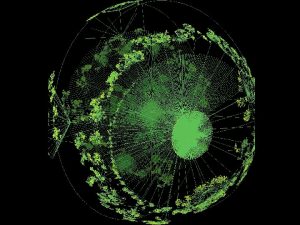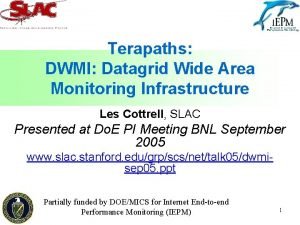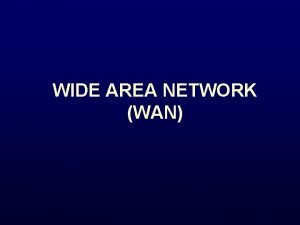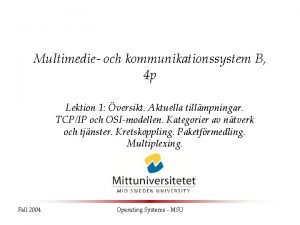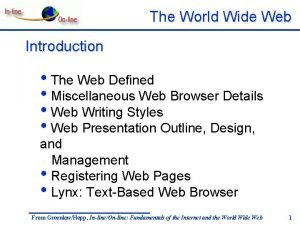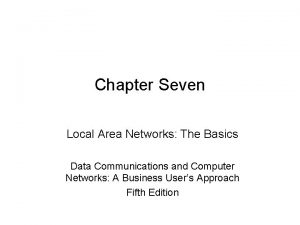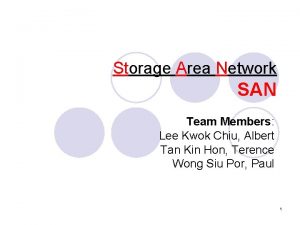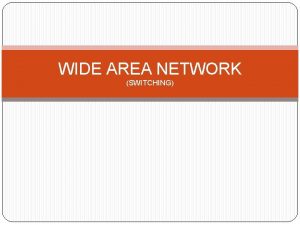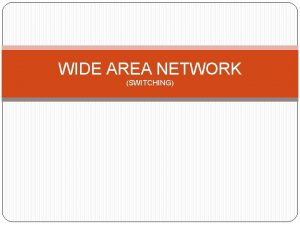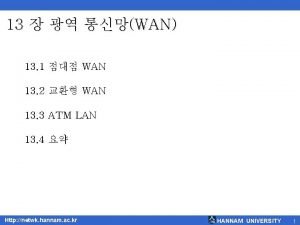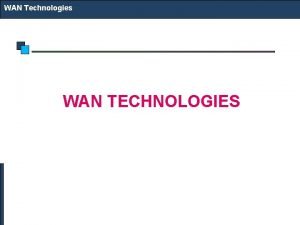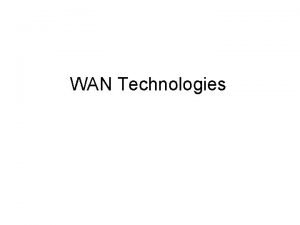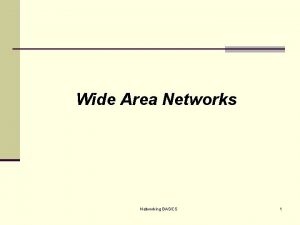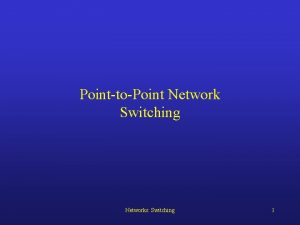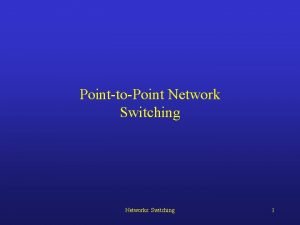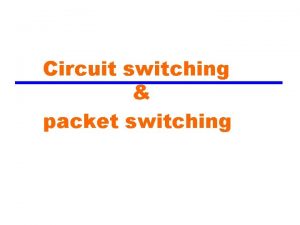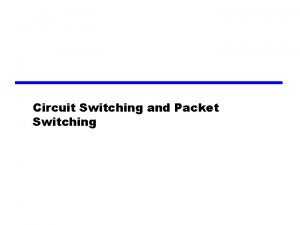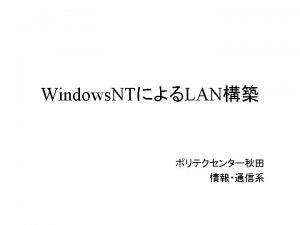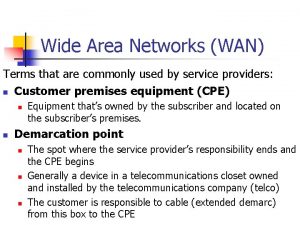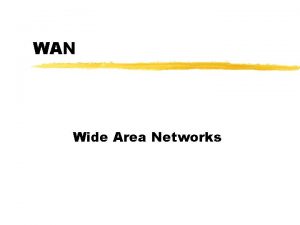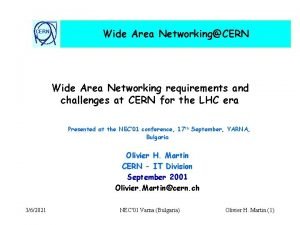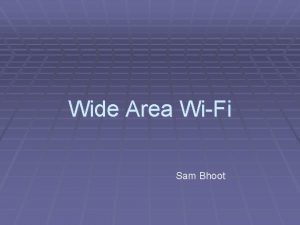Introduction to Wide Area Networks Outline WAN Switching








































- Slides: 40

Introduction to Wide Area Networks

Outline WAN Switching Concepts Circuit and Packet Switching WAN Connection Options Point-to-point Connection Circuit-switched Connection Packet-switched Connection Public WAN connection The WAN Hierarchical Model Core Layer Distribution Layer Access Layer

Outline WAN Switching Concepts Circuit and Packet Switching WAN Connection Options Point-to-point Connection Circuit-switched Connection Packet-switched Connection Public WAN connection The WAN Hierarchical Model Core Layer Distribution Layer Access Layer

WAN Switching Concepts WAN switching technologies form the carrier backbone based on which it delivers communications services. WAN switched networks are categorized as either circuit- switched or packet-switched

Circuit Switching A circuit-switched network is one that establishes a dedicated circuit (or channel) between nodes before the users may communicate.

Packet Switching Packet switching splits traffic data into packets that are routed over a shared network. Packet-switching networks do not require a circuit to be established, and they allow many pairs of nodes to communicate over the same channel.


Packet Switching The routers in a packet-switched network determine the links that packets must be sent over based on the addressing information in each packet. The following are two approaches to this link determination: Connectionless or Connection-oriented

Packet Switching Connectionless networks: Full addressing information must be carried in each packet. Each router must evaluate the address to determine where to send the packet. An example of a connectionless system is the Internet. Each packet is treated independently The destination needs to reorder the packets, and to take care of lost ones

Packet Switching Connection-oriented networks: The network predetermines the route for a packet, and each packet only has to carry an identifier. The router determines the onward route by looking up the identifier in tables held in memory. All the packets to follow the same route in order of submission.

Circuit and Packet Switching The cost of packet switching is lower than that of circuit- switching: Because the links are shared between many users. Delays (latency) and variability of delay (jitter) are greater in packet-switched networks than in circuit-switched networks. Because the links are shared and Because packets must be entirely received at one switch before moving to the next.

Outline WAN Switching Concepts Circuit and Packet Switching WAN Connection Options Point-to-point Connection Circuit-switched Connection Packet-switched Connection Public WAN connection The WAN Hierarchical Model Core Layer Distribution Layer Access Layer

WAN Connection Options There are different WAN connection options to interconnect LANs These WAN access options differ in technology, speed, and cost. Each has distinct advantages and disadvantages.


Dedicated Connection Typically referred to as a point-to-point. It is a pre-established connection from the customer premises through the provider network to a remote destination. The established path is permanent and fixed for each remote network reached through the carrier facilities which allow communication at any time. Since point-to-point lines usually are leased from a carrier, it also called leased lines.


Dedicated Connection Leased lines are available in different capacities. They generally are priced based on the bandwidth required and the distance between the two connected points.

Dedicated Connection It uses synchronous serial lines. Serial transmission means that the bits of a frame are transmitted one at a time over the physical medium. In WANs, the serial connections are preferred because Serial cables can be longer than parallel cables. Synchronization easier than parallel connections. Simpler wiring and less cost.

Dedicated Connection A router serial port and a CSU/DSU is required for each leased-line connection. Synchronization is preserved end to end. HDLC and PPP Data-link protocols are frequently used on them.

Dedicated Connection Pros They provide high bandwidth and constant data rate for data transfer. The dedicated connections removes latency and jitter between the endpoints. The private nature of a dedicated connection allows a corporation better control over the WAN connection

Dedicated Connection Cons Cost: Because the line is not shared, dedicated connections tend to be more costly. Each endpoint needs a separate physical interface on the router, which increases equipment costs. Limited flexibility: WAN traffic is often variable, and leased lines have a fixed capacity, so that the bandwidth of the line seldom matches the need exactly.

Dedicated Connection As a general rule, dedicated connections are most cost- effective in the following situations: Long connect times Short distances Critical traffic requirements that must be guaranteed

Circuit-switched Connection A dedicated physical circuit through a carrier network is established, maintained, and terminated for each communication session. It establishes a data connections when needed and then terminates it when communication is complete. In circuit-switched networks, the resources along the path are reserved for the duration of the communication session.


Circuit-switched Connection It normally provides low bandwidth for data transfer. The advantage of this WAN service is low cost, where subscribers only pay for the duration of the usage. The two most common types of circuit-switched WAN technologies are the public switched telephone network (PSTN) and the Integrated Services Digital Network (ISDN).

Circuit-switched Connection PSTN (Dialup) Transporting binary computer data through the voice telephone network using a modem. It is an option for WAN connection when no other WAN technology is available. It is suitable when intermittent, low-volume data transfers are needed.

Circuit-switched Connection PSTN (Dialup) The advantages of modem and analog lines are simplicity, availability, and low implementation cost. The disadvantages are : The low data rates and a relatively long connection time. The dedicated circuit has little delay or jitter for point-to-point traffic, but voice or video traffic does not operate adequately at these low bit rates.

Circuit-switched Connection ISDN is a circuit-switching technology that enables the local loop of a PSTN to carry digital signals, resulting in higher-capacity switched connections. ISDN changes the internal connections of the PSTN from carrying analog signals to time-division multiplexed (TDM) digital signals. TDM allows two or more signals or bit streams to be transferred as subchannels in one communication channel.

ISDN turns the local loop into a TDM digital connection. This change enables the local loop to carry digital signals that result in higher-capacity switched connections

Packet-switched Connection Packet switching connection is a technology based on the transmission of data in packets. Packets are routed through a carrier network based on the destination address contained within each packet. Examples of Packet switched communication links : Frame Relay and X. 25.

Packet-switched Connection Dividing a data into packets enables data from one or more sources to one or more destinations to share the communication channels within the carrier network. the bandwidth is sharing with other companies save money. It only works well for data transfer in bursty nature; hence leased lines would be the better choice if constant data transfer is required.

Public WAN connection Public connections use the global Internet infrastructure. Service provider offers broadband Internet access using digital subscriber line (DSL), cable, and satellite access. Broadband connection options are typically used to connect small offices and telecommuting employees to a corporate site over the Internet. Data traveling between corporate sites over the public WAN infrastructure should be protected using VPNs.

Outline WAN Switching Concepts Circuit and Packet Switching WAN Connection Options Point-to-point Connection Circuit-switched Connection Packet-switched Connection Public WAN connection The WAN Hierarchical Model Core Layer Distribution Layer Access Layer

The Hierarchical Model The Hierarchical internetworking model is a three-layer model for network design first proposed by Cisco. It divides company networks into three layers: core, distribution, and access layer, each layer focuses on specific functions

The Hierarchical Model

Core Layer The core layer is a high-speed, highly-redundant switching and routing backbone that move packets between distribution-layer devices in different regions of the network. It should be designed to pass network traffic as fast as possible. Core switches and routers are usually the most powerful, in terms of raw forwarding power.

Core Layer This layer of the network should not perform any frame or packet manipulation, such as access lists and filtering, which would slow down the switching of traffic and in turn result in less than a "high-speed" environment.

Distribution Layer Distribution layer is the isolation point between the network’s access layer and core layers. The distribution layer is used for policy base services. It is the smart layer in the three-layer model. Routing, filtering, and Qo. S policies are managed at the distribution layer.

Access Layer The access layer is the point at which local end users are allowed into the network. It responsible for providing access to different network resources. Access layer includes shared LAN, switched LAN and VLAN

CH 1 Learning Outcomes (LOC) WAN overview WAN terms, WAN devices, WAN PHY Layer WAN Switching Concepts WAN connection types: Dedicated leased lines, Circuit switched, Packet switched , public connections WAN design including core, distribution, and access layers.
 Circuit switching packet switching message switching
Circuit switching packet switching message switching Circuit switched wan
Circuit switched wan Introduction to wide area networks
Introduction to wide area networks Przykład sieci wan
Przykład sieci wan Wide area network wan fort myers
Wide area network wan fort myers Wireless wide area network
Wireless wide area network Comparison of virtual circuit and datagram networks
Comparison of virtual circuit and datagram networks Cell switching vs packet switching
Cell switching vs packet switching Packet switched network vs circuit switched network
Packet switched network vs circuit switched network Each packet is treated independently
Each packet is treated independently Cell switching vs packet switching
Cell switching vs packet switching Wan packet switching
Wan packet switching What is a private wan
What is a private wan Data link layer switching
Data link layer switching Switching techniques in computer networks
Switching techniques in computer networks Connectionless internetworking
Connectionless internetworking Uma multiprocessors using multistage switching networks
Uma multiprocessors using multistage switching networks Transistor switching networks
Transistor switching networks Extreme angle photography
Extreme angle photography Evolution of storage area network
Evolution of storage area network Backbone networks in computer networks
Backbone networks in computer networks Mobile wide area network
Mobile wide area network Wawf
Wawf Local area network topology
Local area network topology Cisco waas vs riverbed 2017
Cisco waas vs riverbed 2017 World wide web 3
World wide web 3 Wide area network example
Wide area network example Wireless wide area network
Wireless wide area network Wide area work flow
Wide area work flow Nättopologi
Nättopologi Wide area
Wide area Wawf acceptor training
Wawf acceptor training Wide area monitoring
Wide area monitoring Wide area network adalah
Wide area network adalah Wide area kommunikationssystem
Wide area kommunikationssystem Wan protocols and technologies
Wan protocols and technologies Sentence outline example
Sentence outline example Introduction to world wide web
Introduction to world wide web What are the basic layouts of local area networks
What are the basic layouts of local area networks Storage area networks tutorial
Storage area networks tutorial Types of storage area networks
Types of storage area networks

